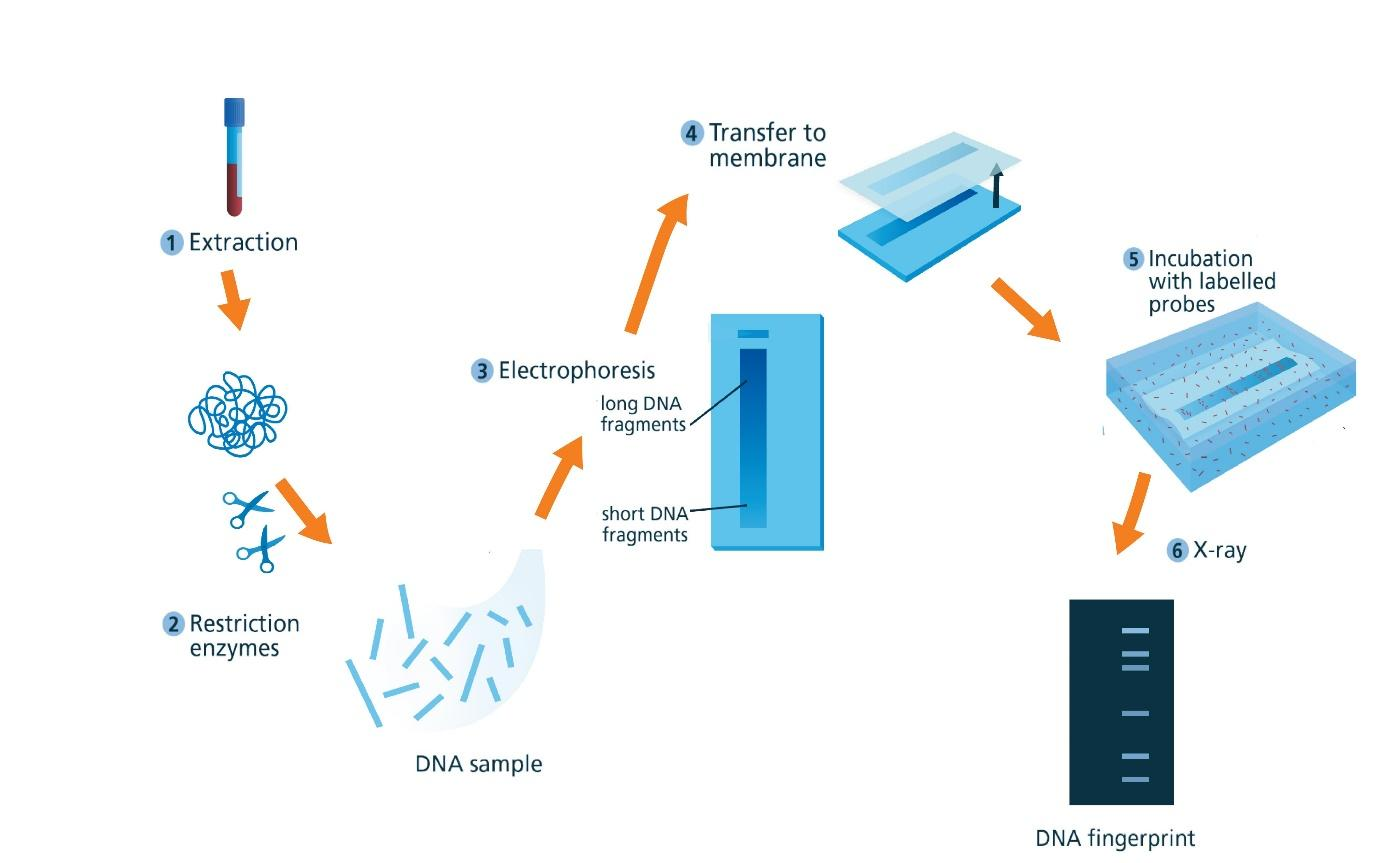
Arrange the various steps in the DNA fingerprinting technique in the correct order:
(i)Separation of DNA fragments by electrophoresis
(ii)Digestion of DNA by restriction endonucleases
(iii)Hybridization using labeled VNTR probe
(iv)Isolation of DNA
(v)Detection of hybridized DNA fragments by autoradiography
(vi)Transferring the separated DNA fragments to nitrocellulose membrane
(a)
(b)
(c)
(d)
Answer
475.8k+ views
Hint: A laboratory genetic technique or process is referred to as DNA fingerprinting to identify people using body samples such as blood, saliva, or hair. The selection of samples, extraction of DNA, digestion, or amplification, and the results of the analysis are significant steps.
Complete answer:
This technique was developed by Alec Jeffreys in which he also used satellite DNAs called VNTRs (Variable Number of Tandem Repeats) as a probe because the high degree of polymorphism was seen.
The measures involved in DNA fingerprinting are below:
Digestion of DNA by restriction endonuclease
Separation of DNA fragments by electrophoresis
Transferring the separated DNA fragments to nitrocellulose membrane
Hybridization using labelled VNTR probe
Detection of hybridized DNA fragments by autoradiography.
In forensic testing and paternity testing, the fingerprinting process is used for DNA analysis. It is also used in evaluating, apart from these two areas, the frequency of a certain gene in a population that gives rise to diversity. Fingerprinting may be used to track the function of this transition in evolution in the event of a shift in gene frequency or genetic drift.
So, the answer is, “
Note: - Satellite DNA regions are repeated DNA stretches that do not code for any particular protein. A big chunk of the human DNA profile is created by these non-coding sequences. They represent a high polymorphism degree and are the basis for fingerprinting DNA. In all kinds of tissues, these genes display a high degree of polymorphism, which makes them very useful in forensic studies.
-The degree of polymorphism in the non-coding repetitive sequences can be studied by any piece of DNA sample found at a crime scene. After tracing the DNA profile, it becomes easier to locate the perpetrator by conducting the suspects' DNA fingerprinting.

Complete answer:
This technique was developed by Alec Jeffreys in which he also used satellite DNAs called VNTRs (Variable Number of Tandem Repeats) as a probe because the high degree of polymorphism was seen.
The measures involved in DNA fingerprinting are below:
Digestion of DNA by restriction endonuclease
Separation of DNA fragments by electrophoresis
Transferring the separated DNA fragments to nitrocellulose membrane
Hybridization using labelled VNTR probe
Detection of hybridized DNA fragments by autoradiography.
In forensic testing and paternity testing, the fingerprinting process is used for DNA analysis. It is also used in evaluating, apart from these two areas, the frequency of a certain gene in a population that gives rise to diversity. Fingerprinting may be used to track the function of this transition in evolution in the event of a shift in gene frequency or genetic drift.
So, the answer is, “
Note: - Satellite DNA regions are repeated DNA stretches that do not code for any particular protein. A big chunk of the human DNA profile is created by these non-coding sequences. They represent a high polymorphism degree and are the basis for fingerprinting DNA. In all kinds of tissues, these genes display a high degree of polymorphism, which makes them very useful in forensic studies.
-The degree of polymorphism in the non-coding repetitive sequences can be studied by any piece of DNA sample found at a crime scene. After tracing the DNA profile, it becomes easier to locate the perpetrator by conducting the suspects' DNA fingerprinting.

Recently Updated Pages
Master Class 9 General Knowledge: Engaging Questions & Answers for Success

Master Class 9 English: Engaging Questions & Answers for Success

Master Class 9 Science: Engaging Questions & Answers for Success

Master Class 9 Social Science: Engaging Questions & Answers for Success

Master Class 9 Maths: Engaging Questions & Answers for Success

Class 9 Question and Answer - Your Ultimate Solutions Guide

Trending doubts
Give 10 examples of unisexual and bisexual flowers

Draw a labelled sketch of the human eye class 12 physics CBSE

Differentiate between homogeneous and heterogeneous class 12 chemistry CBSE

Differentiate between insitu conservation and exsitu class 12 biology CBSE

What are the major means of transport Explain each class 12 social science CBSE

Why is the cell called the structural and functional class 12 biology CBSE




